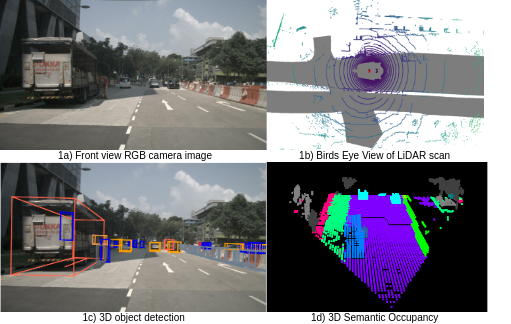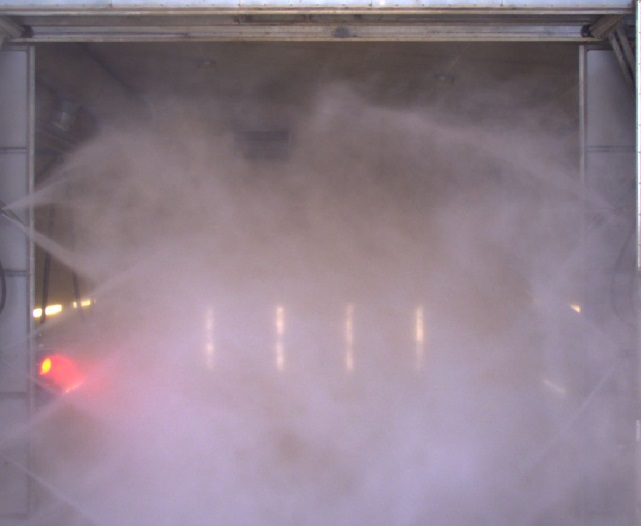RadarOcc: Robust 3D Occupancy Prediction with 4D Imaging Radar
2405.14014

0
0
🔮
Abstract
3D occupancy-based perception pipeline has significantly advanced autonomous driving by capturing detailed scene descriptions and demonstrating strong generalizability across various object categories and shapes. Current methods predominantly rely on LiDAR or camera inputs for 3D occupancy prediction. These methods are susceptible to adverse weather conditions, limiting the all-weather deployment of self-driving cars. To improve perception robustness, we leverage the recent advances in automotive radars and introduce a novel approach that utilizes 4D imaging radar sensors for 3D occupancy prediction. Our method, RadarOcc, circumvents the limitations of sparse radar point clouds by directly processing the 4D radar tensor, thus preserving essential scene details. RadarOcc innovatively addresses the challenges associated with the voluminous and noisy 4D radar data by employing Doppler bins descriptors, sidelobe-aware spatial sparsification, and range-wise self-attention mechanisms. To minimize the interpolation errors associated with direct coordinate transformations, we also devise a spherical-based feature encoding followed by spherical-to-Cartesian feature aggregation. We benchmark various baseline methods based on distinct modalities on the public K-Radar dataset. The results demonstrate RadarOcc's state-of-the-art performance in radar-based 3D occupancy prediction and promising results even when compared with LiDAR- or camera-based methods. Additionally, we present qualitative evidence of the superior performance of 4D radar in adverse weather conditions and explore the impact of key pipeline components through ablation studies.
Create account to get full access
Overview
- This paper presents a novel approach called RadarOcc that leverages 4D imaging radar sensors for 3D occupancy prediction in autonomous driving.
- Current 3D occupancy prediction methods rely on LiDAR or camera inputs, which are susceptible to adverse weather conditions.
- RadarOcc addresses these limitations by directly processing the 4D radar tensor, preserving essential scene details.
- The method employs Doppler bins descriptors, sidelobe-aware spatial sparsification, and range-wise self-attention mechanisms to handle the challenges associated with voluminous and noisy 4D radar data.
- RadarOcc outperforms baseline methods and demonstrates promising results even when compared to LiDAR- or camera-based approaches.
Plain English Explanation
Autonomous driving is a rapidly advancing field that relies on detailed 3D scene understanding to navigate safely. Current methods predominantly use LiDAR (Light Detection and Ranging) or cameras to capture this 3D information, but these sensors can be affected by adverse weather conditions, limiting the all-weather deployment of self-driving cars.
To address this issue, the researchers in this paper have developed a new approach called RadarOcc that utilizes 4D imaging radar sensors for 3D occupancy prediction. Radar sensors are less affected by weather conditions, making them a promising alternative to LiDAR and cameras.
However, the radar data can be voluminous and noisy, presenting unique challenges. RadarOcc tackles these challenges through several innovative techniques, such as using Doppler bins descriptors, sidelobe-aware spatial sparsification, and range-wise self-attention mechanisms. These methods help the system effectively process the complex 4D radar data and extract the essential 3D scene information.
The researchers also devised a spherical-based feature encoding and spherical-to-Cartesian feature aggregation to minimize the interpolation errors associated with direct coordinate transformations.
When tested on a public dataset, RadarOcc demonstrated state-of-the-art performance in radar-based 3D occupancy prediction and even outperformed some LiDAR- or camera-based methods. The paper also provides qualitative evidence of the superior performance of 4D radar in adverse weather conditions.
Technical Explanation
The paper introduces a novel RadarOcc approach for 3D occupancy prediction using 4D imaging radar sensors. This is a departure from the predominant methods that rely on LiDAR or camera inputs, which can be susceptible to adverse weather conditions.
RadarOcc addresses the limitations of sparse radar point clouds by directly processing the 4D radar tensor, preserving essential scene details. To handle the voluminous and noisy 4D radar data, the method employs several key innovations:
- Doppler bins descriptors: These descriptors capture the motion information encoded in the radar data.
- Sidelobe-aware spatial sparsification: This technique mitigates the effects of radar sidelobes, which can introduce unwanted artifacts.
- Range-wise self-attention mechanisms: These attention mechanisms help the system focus on the most relevant features along the range dimension of the radar data.
To minimize the interpolation errors associated with direct coordinate transformations, the researchers also devised a spherical-based feature encoding followed by spherical-to-Cartesian feature aggregation.
The authors benchmark their approach against various baseline methods on the K-Radar dataset. The results demonstrate that RadarOcc achieves state-of-the-art performance in radar-based 3D occupancy prediction and promising results even when compared to LiDAR- or camera-based methods.
Additionally, the paper presents qualitative evidence of the superior performance of 4D radar in adverse weather conditions and explores the impact of key pipeline components through ablation studies.
Critical Analysis
The paper presents a compelling approach to leveraging 4D imaging radar for 3D occupancy prediction in autonomous driving, addressing the limitations of existing methods that rely on LiDAR or camera inputs. The key innovations, such as the use of Doppler bins descriptors, sidelobe-aware spatial sparsification, and range-wise self-attention mechanisms, demonstrate a thoughtful approach to handling the unique challenges of radar data.
However, the paper does not provide a detailed discussion of the potential limitations or areas for further research. For example, it would be interesting to understand the computational complexity and real-time performance of the RadarOcc pipeline, as well as its robustness to sensor failures or calibration issues.
Additionally, the paper could have explored the potential trade-offs between the performance gains of RadarOcc and the cost or complexity of the 4D radar sensors compared to LiDAR or camera-based systems. A more comprehensive comparison across a wider range of environmental conditions and scene types could also provide valuable insights.
Conclusion
This paper presents a novel RadarOcc approach that leverages 4D imaging radar sensors for 3D occupancy prediction in autonomous driving. By directly processing the 4D radar tensor and employing innovative techniques to handle the data's challenges, RadarOcc demonstrates state-of-the-art performance and shows promise in addressing the limitations of LiDAR- and camera-based methods, particularly in adverse weather conditions.
The research highlights the potential of radar technology to enhance the robustness and reliability of autonomous driving systems, which is a critical step towards the widespread adoption of self-driving cars. While the paper could have delved deeper into the potential limitations and areas for further exploration, it nonetheless contributes a valuable and compelling solution to the ongoing pursuit of comprehensive 3D scene understanding for autonomous vehicles.
This summary was produced with help from an AI and may contain inaccuracies - check out the links to read the original source documents!
Related Papers

OccFusion: A Straightforward and Effective Multi-Sensor Fusion Framework for 3D Occupancy Prediction
Zhenxing Ming, Julie Stephany Berrio, Mao Shan, Stewart Worrall

0
0
A comprehensive understanding of 3D scenes is crucial in autonomous vehicles (AVs), and recent models for 3D semantic occupancy prediction have successfully addressed the challenge of describing real-world objects with varied shapes and classes. However, existing methods for 3D occupancy prediction heavily rely on surround-view camera images, making them susceptible to changes in lighting and weather conditions. This paper introduces OccFusion, a novel sensor fusion framework for predicting 3D occupancy. By integrating features from additional sensors, such as lidar and surround view radars, our framework enhances the accuracy and robustness of occupancy prediction, resulting in top-tier performance on the nuScenes benchmark. Furthermore, extensive experiments conducted on the nuScenes and semanticKITTI dataset, including challenging night and rainy scenarios, confirm the superior performance of our sensor fusion strategy across various perception ranges. The code for this framework will be made available at https://github.com/DanielMing123/OccFusion.
5/10/2024

Vision-based 3D occupancy prediction in autonomous driving: a review and outlook
Yanan Zhang, Jinqing Zhang, Zengran Wang, Junhao Xu, Di Huang

0
0
In recent years, autonomous driving has garnered escalating attention for its potential to relieve drivers' burdens and improve driving safety. Vision-based 3D occupancy prediction, which predicts the spatial occupancy status and semantics of 3D voxel grids around the autonomous vehicle from image inputs, is an emerging perception task suitable for cost-effective perception system of autonomous driving. Although numerous studies have demonstrated the greater advantages of 3D occupancy prediction over object-centric perception tasks, there is still a lack of a dedicated review focusing on this rapidly developing field. In this paper, we first introduce the background of vision-based 3D occupancy prediction and discuss the challenges in this task. Secondly, we conduct a comprehensive survey of the progress in vision-based 3D occupancy prediction from three aspects: feature enhancement, deployment friendliness and label efficiency, and provide an in-depth analysis of the potentials and challenges of each category of methods. Finally, we present a summary of prevailing research trends and propose some inspiring future outlooks. To provide a valuable reference for researchers, a regularly updated collection of related papers, datasets, and codes is organized at https://github.com/zya3d/Awesome-3D-Occupancy-Prediction.
5/7/2024

Real-time 3D semantic occupancy prediction for autonomous vehicles using memory-efficient sparse convolution
Samuel Sze, Lars Kunze

0
0
In autonomous vehicles, understanding the surrounding 3D environment of the ego vehicle in real-time is essential. A compact way to represent scenes while encoding geometric distances and semantic object information is via 3D semantic occupancy maps. State of the art 3D mapping methods leverage transformers with cross-attention mechanisms to elevate 2D vision-centric camera features into the 3D domain. However, these methods encounter significant challenges in real-time applications due to their high computational demands during inference. This limitation is particularly problematic in autonomous vehicles, where GPU resources must be shared with other tasks such as localization and planning. In this paper, we introduce an approach that extracts features from front-view 2D camera images and LiDAR scans, then employs a sparse convolution network (Minkowski Engine), for 3D semantic occupancy prediction. Given that outdoor scenes in autonomous driving scenarios are inherently sparse, the utilization of sparse convolution is particularly apt. By jointly solving the problems of 3D scene completion of sparse scenes and 3D semantic segmentation, we provide a more efficient learning framework suitable for real-time applications in autonomous vehicles. We also demonstrate competitive accuracy on the nuScenes dataset.
5/21/2024

Human Detection from 4D Radar Data in Low-Visibility Field Conditions
Mikael Skog, Oleksandr Kotlyar, Vladim'ir Kubelka, Martin Magnusson

0
0
Autonomous driving technology is increasingly being used on public roads and in industrial settings such as mines. While it is essential to detect pedestrians, vehicles, or other obstacles, adverse field conditions negatively affect the performance of classical sensors such as cameras or lidars. Radar, on the other hand, is a promising modality that is less affected by, e.g., dust, smoke, water mist or fog. In particular, modern 4D imaging radars provide target responses across the range, vertical angle, horizontal angle and Doppler velocity dimensions. We propose TMVA4D, a CNN architecture that leverages this 4D radar modality for semantic segmentation. The CNN is trained to distinguish between the background and person classes based on a series of 2D projections of the 4D radar data that include the elevation, azimuth, range, and Doppler velocity dimensions. We also outline the process of compiling a novel dataset consisting of data collected in industrial settings with a car-mounted 4D radar and describe how the ground-truth labels were generated from reference thermal images. Using TMVA4D on this dataset, we achieve an mIoU score of 78.2% and an mDice score of 86.1%, evaluated on the two classes background and person
4/9/2024